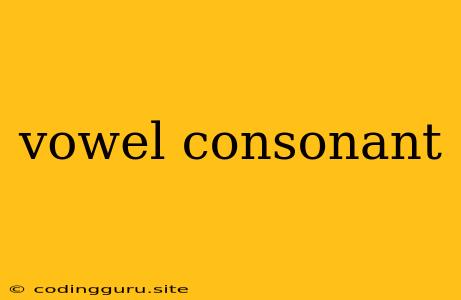The Building Blocks of Language: Vowels and Consonants
The very foundation of spoken language is built upon two fundamental categories of sounds: vowels and consonants. While seemingly simple, these sound types play a crucial role in shaping the meaning and rhythm of every word we utter. Let's delve into the characteristics and importance of vowels and consonants.
What are Vowels?
Vowels are the sounds produced with an open vocal tract, allowing air to flow freely without any obstruction. This openness allows for a continuous stream of sound. Think of the sounds "ah," "ee," and "oo." These are all vowels because the air is not blocked by any part of your mouth or throat during pronunciation.
What are Consonants?
In contrast to vowels, consonants are produced with a partial or complete obstruction of airflow within the vocal tract. This obstruction can occur at various points, such as the lips, teeth, tongue, or soft palate. Think of the sounds "b," "d," "m," and "s." Each of these sounds involves some degree of blockage to modify the air stream.
How do Vowels and Consonants Work Together?
Vowels and consonants work together in a harmonious symphony to form words. Vowels act as the core, the foundation upon which consonants add structure and meaning. Imagine a word like "cat." The vowel "a" provides the core sound, while the consonants "c" and "t" add shape and definition.
The Importance of Distinguishing Vowels and Consonants
Understanding the difference between vowels and consonants is crucial for several reasons:
- Pronunciation: Accurately identifying vowels and consonants is essential for speaking a language clearly and correctly.
- Spelling: In many languages, the spelling system directly reflects the distinction between vowels and consonants.
- Language Learning: Recognizing vowels and consonants is a fundamental step in learning any new language.
- Linguistics: The study of vowels and consonants is a cornerstone of phonetics and phonology, the branches of linguistics that investigate sound systems.
Identifying Vowels and Consonants
Here are some tips for identifying vowels and consonants:
- Vocal Tract: Vowels are produced with an open vocal tract, while consonants involve some form of obstruction.
- Sound Duration: Vowels can be sustained for a longer period, while consonants tend to be shorter and more transient.
- Word Position: In many languages, vowels typically occupy the central position of a word, while consonants are found at the beginning and end.
Examples
Let's look at some examples of how vowels and consonants combine to create words:
- Cat: "c" (consonant), "a" (vowel), "t" (consonant)
- Dog: "d" (consonant), "o" (vowel), "g" (consonant)
- Bird: "b" (consonant), "i" (vowel), "r" (consonant), "d" (consonant)
Conclusion
The distinction between vowels and consonants is fundamental to understanding and using language. While simple in concept, these sound categories play a critical role in shaping the sounds, structure, and meaning of every word we speak. By understanding the characteristics and functions of vowels and consonants, we gain a deeper appreciation for the intricacies of language and the remarkable way these building blocks come together to create a vast tapestry of human expression.
